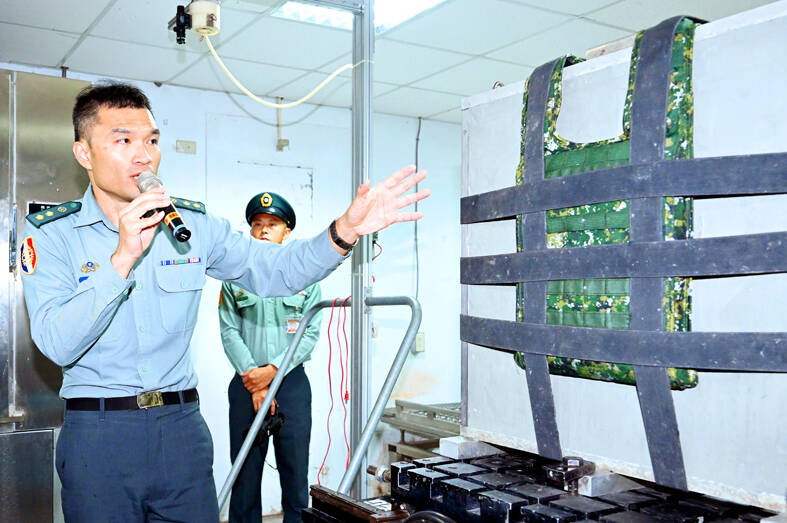The military plans to purchase 48,000 new boron carbide bullet-resistant ceramic plates, the Ministry of National Defense’s latest list of regulated military material showed.
Mass production of the plates is scheduled for between 2028 and 2029, according to the document that was released last week.
The plates are capable of protecting against up to 7.62mm armor-piercing ammunition or shrapnel.

Photo: Liao Chen-huei, Taipei Times
The budget is set at NT$840 million (US$28.08 million) for the 48,000 sets of plates in 2028 and 2029, the document showed, after an initial procurement of 30 units for NT$1.395 million.
The list does not indicate the plates’ protective rating, but the specifications for NIJ IV-level body armor — resisting a .30 caliber M2 armor-piercing round — are similar to that of the new armor.
Details on the protective rating, weight and which branches of the military are to adopt the armor are not yet public knowledge.
The current NIJ III-rated plates in use by the armed forces are designed to stop standard 7.62mm by 51mm NATO ammunition, the ministry said.
Armor plates that entered mass production this year have three layers of ceramic materials and polyethylene fibers, with 60,000 expected to be mass-produced and delivered to the military this year.
To protect against the 5.8mm steel-core rounds used by the Chinese People’s Liberation Army, as well as ordinary 7.62mm bullets, they were developed according to the Enhanced Small Arms Protective Insert specifications used by the US military, the ministry said.
The ministry in February signed a NT$1.6 billion contract to purchase 160,000 ceramic plates.
The ministry’s list of controlled materials includes both the body armor and the research used to develop them.
Boron carbide is among the hardest known materials, and is also lightweight, making it ideal for protective applications.
The export control military use list outlines items subject to export authorization due to their potential applications in national defense. Since 2021, the ministry has released the list annually in accordance with the National Defense Industry Development Act (國防產業發展條例).
Additional reporting by CNA

TRAGEDY STRIKES TAIPEI: The suspect died after falling off a building after he threw smoke grenades into Taipei Main Station and went on a killing spree in Zhongshan A 27-year-old suspect allegedly threw smoke grenades in Taipei Main Station and then proceeded to Zhongshan MRT Station in a random killing spree that resulted in the death of the suspect and two other civilians, and seven injured, including one in critical condition, as of press time last night. The suspect, identified as a man surnamed Chang Wen (張文), allegedly began the attack at Taipei Main Station, the Taipei Fire Department said, adding that it received a report at 5:24pm that smoke grenades had been thrown in the station. One man in his 50s was rushed to hospital after a cardiac arrest

SAFETY FIRST: Double the number of police were deployed at the Taipei Marathon, while other cities released plans to bolster public event safety Authorities across Taiwan have stepped up security measures ahead of Christmas and New Year events, following a knife and smoke bomb attack in Taipei on Friday that left four people dead and 11 injured. In a bid to prevent potential copycat incidents, police deployments have been expanded for large gatherings, transport hubs, and other crowded public spaces, according to official statements from police and city authorities. Taipei Mayor Chiang Wan-an (蔣萬安) said the city has “comprehensively raised security readiness” in crowded areas, increased police deployments with armed officers, and intensified patrols during weekends and nighttime hours. For large-scale events, security checkpoints and explosives

A car bomb killed a senior Russian general in southern Moscow yesterday morning, the latest high-profile army figure to be blown up in a blast that came just hours after Russian and Ukrainian delegates held separate talks in Miami on a plan to end the war. Kyiv has not commented on the incident, but Russian investigators said they were probing whether the blast was “linked” to “Ukrainian special forces.” The attack was similar to other assassinations of generals and pro-war figures that have either been claimed, or are widely believed to have been orchestrated, by Ukraine. Russian Lieutenant General Fanil Sarvarov, 56, head

PUBLIC SAFETY: The premier said that security would be tightened in transport hubs, while President Lai commended the public for their bravery The government is to deploy more police, including rapid response units, in crowded public areas to ensure a swift response to any threats, President William Lai (賴清德) said yesterday after a knife attack killed three people and injured 11 in Taipei the previous day. Lai made the remarks following a briefing by the National Police Agency on the progress of the investigation, saying that the attack underscored the importance of cooperation in public security between the central and local governments. The attack unfolded in the early evening on Friday around Taipei Main Station’s M7 exit and later near the Taipei MRT’s Zhongshan